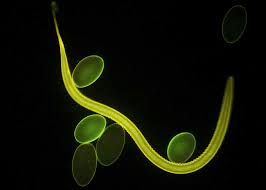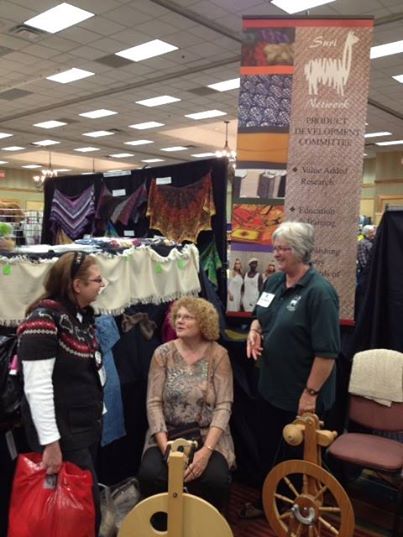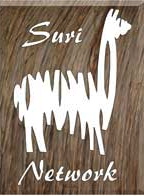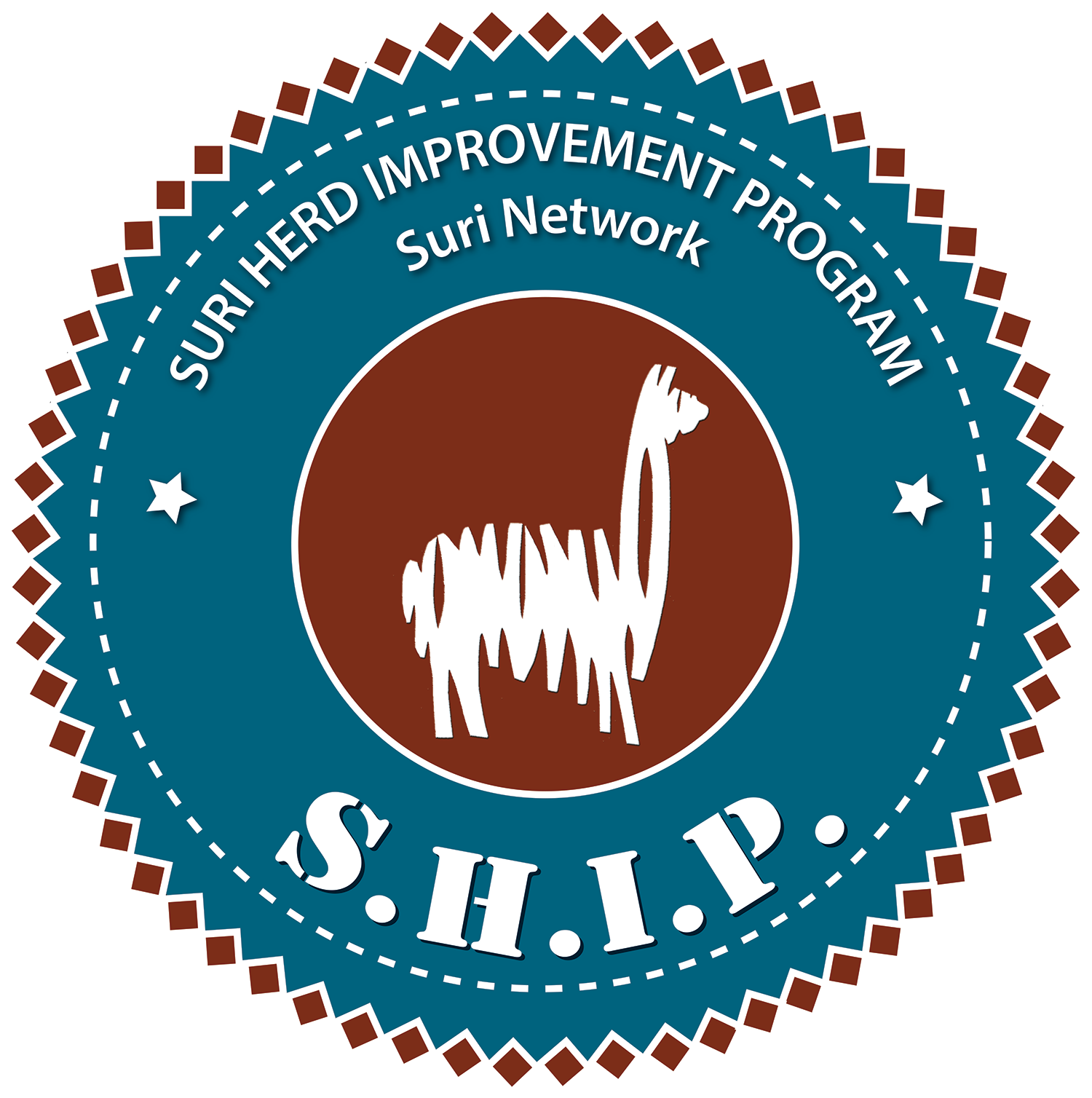| Suri Network News |
March 2014 |
|
President's Letter Who’s ready for Spring! As I am sitting in the kitchen writing this letter, the howling wind outside is making it feel like 25 degrees below zero! Enough is enough. The Suris are getting “cabin fever” and are more than ready to run outside in green grass rather than being belly deep in snow. But you know what, Spring always comes and with it other challenges in the life of alpaca farming. One of those challenges for many alpaca owners is managing parasites. In this issue, Suri Network member Jill McElderry Maxwell writes on "Ways to Minimize Exposure to Haemonchus". Be sure to read this timely article to make sure you are prepared for for the parasite season. I also want to mention the Suri Network’s first live update web cast. In January, almost 60 Suri Network members logged onto their computers to participate in a live meeting presented by the Board of Trustees. Board members provided updates on several of the programs and service the Suri Network is working on. Participants also got to participate in live polls that provided immediate feedback to the board. Those that joined in indicated that this was a great way to communicate with the membership. We plan on having more of these in the future, but if you missed this one, you can watch a recording here. Finally, as Spring show season is underway, we would like to invite you to to attend a Suri Network Rally which will be held at several Alpaca shows this season. The rallies are designed to update our members on what the organization is working on and to provide an opportunity for Suri breeders to network with each other. Check out the article in this issue for more information about the show rallies. The Suri Network continues to work on innovative ways to better serve our members and provide real value for your membership. Please let us know if there is anything we can do better. Sincerely, Tim Sheets - President Suri Network Suri Network 2014 Show Rallies By Joyce White, Suri Network Board Member Are you looking for more from the Suri Network? Would you like to ask the board members questions face to face? Well here is your opportunity! We will be holding Rallies at the shows listed below. These Rallies are to keep our members updated with all the latest Suri Network projects. One or more of the Suri Network Board Members will be there to answer any questions you may have. The Suri Network will be offering the chance to sign up for a FREE one year membership and Advertising discounts in the Purely Suri magazine and on the new Suri Network website. Each show will announce the day and time for the Rally, so make sure you pay close attention to the show announcements. At some shows, the rally information may be listed in the show books.
The Suri Network Board Members look forward to meeting and talking with you at the shows. Renew or Join Now - Great Incentive!! When you renew your membership or join Suri Network for the first time, your name will be entered in a drawing for pre-paid airfare, up to $400.00, to the 2014 Suri Symposium in Estes Park, CO. You must have joined, or renewed, your membership between 6-1-2013 and 5-31-2014 to be eligible for the drawing. If the winner is from Colorado, the winner will receive $200 towards Symposium registrations and one night hotel stay. Don't miss this great opportunity! 2014 Summer Symposium & Fleece Show Living the Vision: U.S. as the Worldwide Suri Source
Suri Fiber Important to AFCNA By Wade Gease, President AFCNA The Alpaca Fiber Cooperative of North America, Inc. (AFCNA) is an agricultural cooperative owned and operated by alpaca farmers working together to add value to their raw product and strengthen their marketing power. Since 1998, AFCNA has been helping alpaca farmers by collecting, grading and adding value to the fiber produced by its member farms and by selling high quality alpaca fiber end products under its brand America’s Alpaca, primarily sold through member farm stores. AFCNA invites all alpaca fiber producers who share our vision and goal of growing and sustaining the North American alpaca community to join our growing cooperative. Suri fiber is VERY important to AFCNA! In the 2013 clip collection AFCNA members submitted over 52,000 pounds of fiber which is in process of being graded for production purposes now. Based on our many years of history, 20% of the fiber collected by AFCNA is suri, so we expect we received about 10,000 pounds of fiber from suri producers last year. We have set our collection goal for 2014 at 75,000 pounds – which means we are working to collect over 14,000 pounds of suri fiber from our members this year. However, Suri fiber is extra challenging for AFCNA to make and market fiber products! In order to make high quality suri products in commercial production volumes, we must begin with quality suri fiber…….. and lots of it. In the 2012 clip collection, out of over 10,000 pounds of suri fiber received by AFCNA, only 37% - about 4000 pounds – was suitable for production. The rest was either too coarse or too long! Hopefully 2012 was just an abnormally bad year. In 2011, we only received about 4,000 pounds suri fiber but a solid 70% of it was of useful production grades. We are very hopeful that AFCNA’s suri producers’ 2013 contribution will once again reflect a higher usable percentage. Suri – sure is different from huacacya! There are extra challenges in making high quality, luxurious suri products even after it is graded. For one thing – there just isn’t as much of it so it’s harder to accumulate enough to run in commercial volumes. It’s harder to get suri scoured properly to take advantage of its natural luster; it’s harder to find a spinner that knows how to make a yarn that really accentuates its natural drape; it’s harder to find a knitting or weaving mill that knows how o make a finished garment or household item worthy of suri’s special properties. While almost all suri fiber in Peru is used for coats, we would like to see it used in a variety of products, like Huacaya. AFCNA is currently marketing some very nice knitting yarns and beautiful woven blankets made in USA from suri fiber contributed by our members. We are very proud of our current line of suri products, and we are working to develop and bring to market more suri fiber products in 2014. For even greater use of suri fiber, we have also incorporated a percentage into our Extreme socks. AFCNA wants your suri fiber. We truly do. But YOU have to do your part. AFCNA has worked hard over the past few years to make contributing fiber as easy and inexpensive as possible. Each year, we introduce more and more collection locations. Only 500# is required to qualify for AFCNA-paid shipping. You don’t even have to skirt after shearing if you don’t have time or training to do it. And we are pleased that every year we collect more and more fiber. Whether you are a full steam ahead Breeding Farm, a Fiber Farm or a “just because I love ’em” hobby farm, every kind of alpaca farmer produces fiber. But not every alpaca produces commercially useful fiber! We understand – because we are alpaca farmers too – what a hardship it is for a member to send in his clip to the co-op and then not to get full graded contribution credit for it! But sorting out and disposing of non-usable fiber hurts everyone in the co-op because we pay freight to bring that fiber to Decatur; we pay grader salaries; and we even have to pay waste disposal expenses for fiber which can’t be used. AFCNA needs every alpaca farmer to be able to evaluate what part of his harvest is actually commercially useful and to only send those grades of fiber to the co-op. So - how may we help you? We need to hear from you. What do you need AFCNA to do to help you pre-screen your co-op contribution so that you can keep, use or dispose of your NCV fiber at the farm? A free clinic to help you learn how to estimate your own microns? A small reference card with a few labeled micron fibers on it? Both? We invite you to get involved, to communicate your needs, to help us help you. Kind Regards, Wade Gease, President Starr Cash, Business Manager Haemonchus Contortus by Jill McElderry-Maxwell  Haemonchus contortus, also known as barber pole worm for the red and white striped coloring of the adult female, is one of the most economically devastating parasites facing small ruminant producers around the world. Barber pole worm is common throughout North America, including Canada. This is a parasite that almost every alpaca owner will some day face. Haemonchus contortus, also known as barber pole worm for the red and white striped coloring of the adult female, is one of the most economically devastating parasites facing small ruminant producers around the world. Barber pole worm is common throughout North America, including Canada. This is a parasite that almost every alpaca owner will some day face.Haemonchus is a strongyle, but not a typical one. Unlike most of the “stomach worms,” barber pole lives in the abomasum and feeds directly on blood, rapidly causing anemia and death in severe cases. It can reproduce very quickly under ideal conditions – adult females are capable of laying 5,000 to 10,000 eggs daily over their several month lifespan. When conditions aren’t ideal, Haemonchus worms can enter a state of suspended animation called hypobiosis, embedding themselves in the gut wall and waiting for conditions better favoring larval survival. The worm has a prepatent period of approximately two to three weeks, during which time adults are active and feeding, but not yet producing eggs – meaning that a host may sicken and die before ever having a positive fecal exam. If this weren’t enough, barber pole mutates very rapidly and may develop resistance to a dewormer in as few as two exposures, according to the work of Dr. Lisa Williamson at the University of Georgia. The historic practice of routine, herd wide deworming on many ruminant farms has created populations of Haemonchus that are resistant to all available dewormers, even levamisole. So what’s an alpaca farmer to do? There are several ways that husbandry practices can minimize the impact of barber pole – and other gut worms – on your herd. One of the most important is maintaining a low stocking density. Too many animals on too little land creates a number of issues that lead to increased parasitism. Crowded animals are stressed animals, particularly if they are low in the herd hierarchy. Dominant animals may keep others from food, water and resting places, or physically harass lower ranking animals. Any source of stress lowers an animal’s ability to fight off parasitic infections, and Haemonchus is quick to take advantage. When many animals share a limited area, they also tend to eat closer to manure piles, as well as to eat their preferred forages down to the ground. Both practices increase the number of larvae alpacas are likely to ingest. Haemonchus infective larvae live in the pasture at the base of grass blades. When the grass is long, alpacas eat above where most of the larvae are located, but when they eat the grass short, they also eat the larvae. The larvae crawl higher on the grass blades when it is damp or wet – keeping your herd off pasture until the dew is dry will minimize their exposure to the infective larvae. Haemonchus likes moist, warm conditions – eggs and larvae typically do not begin developing until the weather is 50°F or warmer, and development slows or stops when the weather becomes hot and dry. This means that timing your herd’s grazing can also help avoid the first flush of larvae each season – keeping them off that beautiful grass in the spring until it has been growing well for two to three weeks (as hard as that is!), will allow the first hatch of larvae to develop and either die, or be located below the level where the alpacas are grazing. Your local veterinarian should know the time of greatest risk to ruminants in your particular area. If at all possible, rotate your alpacas through multiple pastures. Moving animals every three weeks to fresh grazing limits exposure to the parasites deposited in that pasture – that pasture should not be grazed again for at least a month or ideally, even longer. Larval survival is very poor in hot, dry conditions, but in warm, moist weather, infective larvae can live up to six months. Running a monogastric behind your alpacas can further reduce the number of parasite larvae present, as horses, donkeys, pigs, etc. can all ingest ruminant parasites without harm – and the parasites they leave behind are harmless to the alpacas in turn. Even with the best husbandry, it is inevitable that Haemonchus will get the upper hand in some animals. Routinely checking fecal samples is an excellent way for breeders to track parasites in their herd. Most experts feel that barber pole cannot be visually distinguished from other strongyles, but the University of Oregon offers positive identification through the peanut lectin assay (http://vetmed.oregonstate.edu/diagnostic/haemonchus-contortus-identification). During periods of high risk, weekly weighing and the use of FAMACHA scoring (http://www.scsrpc.org/SCSRPC/FAMACHA/famacha.htm) can also help to identify animals with barber pole, even if fecal results are clear. Product Development Committee Update
Please "Like" our new Facebook page: Suri Network Product Development Committee We will keep you updated on projects and advancements. Send us comments, experiences and questions!
2013 Symposium Fiber Arts Winners!
Festivals  The PDC hosted an educational booth, staffed by Donna Rudd, at the Spin Off Autumn Retreat (SOAR) in late October. Several Suri Network members attended SOAR with their wonderful Suri products. They were able to send potential customers to the PDC booth, where Donna could educate and instruct them on the great attributes of Suri and how to work with Suri. The PDC hosted an educational booth, staffed by Donna Rudd, at the Spin Off Autumn Retreat (SOAR) in late October. Several Suri Network members attended SOAR with their wonderful Suri products. They were able to send potential customers to the PDC booth, where Donna could educate and instruct them on the great attributes of Suri and how to work with Suri.Donna was very thankful to the Suri Network members who stopped by the booth and helped: Beth Sheets (Heritage Farm Suri Alpacas), her friend Mary Ann, Pam Kunke (Creekside Natural Farm), and Kat Medrea (M2A Farm Suri Alpacas). Publications Two new publications are available from the PDC. Ten Reasons to Love and Use Suri Fiber Woven Fabric Report, by Beth Brown and Donna Rudd. This report is an example of the kinds of projects the Product Development Committee conducts in order to assist Suri Network members. Don't miss all the great information about weaving with Suri that this report provides. Kudos Korner  Congratulations to Suri Network member Jill McElderry-Maxwell on publication of her articles on E. Mac and thiamine deficiency in Germany. Congratulations to Suri Network member Jill McElderry-Maxwell on publication of her articles on E. Mac and thiamine deficiency in Germany.In April 2013, the German Alpaka Post, “The Journal for Alpaca Breeding”, published her article on “Eimeria macusanienis” (E. mac), and in December 2013 the magazine published Jill’s article “Thiamine deficiency and polioencephalomalacia: What every alpaca owner needs to know.” The Alpaka Post is published by the Alpaka Zucht Verband Deutschland e.V., German’s equivalent of AOBA. An Australian alpaca journal has also contacted Jill for publication this year. Jill has been raising Suri alpacas at Bag End Suris of Maine, LLC, since 2007, actively showing and participating in many industry organizations. She was a student of biological anthropology at Swarthmore College and Kent State University. Since then, she has done a little bit of everything, from selling antiques, to teaching Spanish, to working as a ghostwriter and editor. Jill has enjoyed raising alpacas the most. Kudos Corner recognizes the many skills, talents and accomplishments of Suri Network members. If you are aware of a Suri Network member who has received an honor, award or other recognition of their accomplishments, please send that information tooffice@surinetwork.org
|



 1st Place
1st Place 1st Place
1st Place